Explore Tungnath Temple with Chopta Chandrashila Trek
Embarking on the Chopta Tungnath Trek and Chandrashila Trek is an unforgettable adventure that combines spirituality and natural beauty. Tungnath Temple, situated at an altitude of 3,680 meters, is the highest Shiva temple in the world. This ancient shrine offers not only religious significance but also breathtaking views of the Himalayas.
The Chandrashila Trek takes you even higher, to the summit at 4,000 meters, where panoramic vistas of peaks like Nanda Devi and Chaukhamba await. The journey is adorned with rhododendron forests and alpine meadows, making it a paradise for nature lovers. Many travelers opt for Tungnath Chandrashila Trek from Delhi or Chopta Chandrashila Trek from Delhi, with convenient tour packages that cover transportation and accommodations.
Chopta, the gateway to these treks, is a serene hamlet surrounded by lush greenery and snow-clad peaks. Whether you choose a Chopta tour package or explore independently, the trails offer a blend of adventure and tranquility. From the spiritual ambiance of Tungnath Temple to the thrill of the Chandrashila summit trek, this journey promises memories to last a lifetime.

Tungnath Temple: A Spiritual Haven Amidst the Himalayas
Nestled at an altitude of 3,680 meters, Tungnath Temple is the highest of the five Panch Kedar temples dedicated to Lord Shiva. This ancient temple, believed to be over a thousand years old, holds immense religious significance. According to Hindu mythology, Tungnath is where Lord Shiva’s arms were discovered. Pilgrims and trekkers alike find solace and inspiration here, as the serene ambiance of the temple is unlike any other.
The Tungnath Temple Trek is relatively short but steep, offering captivating views of the snow-clad Himalayan peaks. The journey to this spiritual haven is an experience of inner peace and devotion, making it a must-visit destination for spiritual and adventure travelers alike.
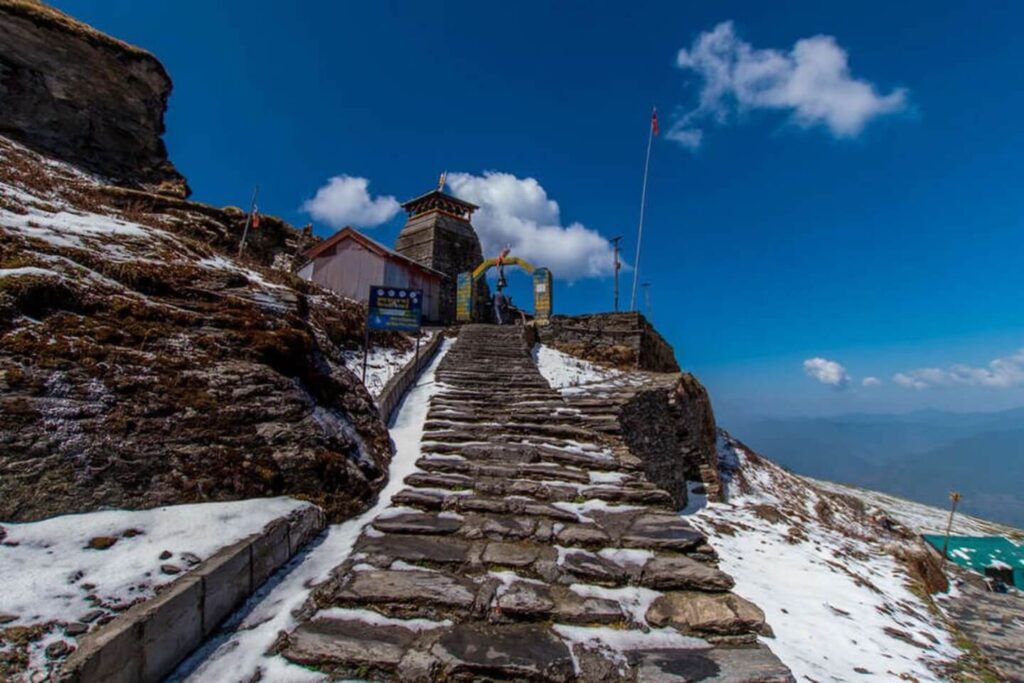
Chandrashila: The Summit of Serenity and Adventure
Standing at an impressive 4,000 meters above sea level, Chandrashila translates to “Moon Rock.” This summit offers a 360-degree panoramic view of the majestic Himalayan ranges, including Nanda Devi, Trishul, Chaukhamba, and Kedarnath peaks. According to legend, Chandrashila is the place where Lord Rama meditated after defeating Ravana, adding a mythical allure to its natural beauty.
The Chandrashila Summit Trek is a challenging yet rewarding adventure. The trail is adorned with rhododendron forests, alpine meadows, and diverse wildlife, making it a favorite among nature lovers and photographers.
Chopta: The Gateway to Adventure and Peace
Known as the starting point for both the Tungnath and Chandrashila treks, Chopta is a tranquil hamlet in Uttarakhand. Often referred to as the “Mini Switzerland of India,” this picturesque destination is surrounded by lush greenery, towering deodar trees, and stunning mountain views. Chopta serves as an ideal base for trekkers and offers a peaceful escape from the hustle and bustle of urban life.
For those looking for a comprehensive travel experience, Chopta tour packages often include trekking, camping, and exploring the local culture, making it easier for visitors to immerse themselves in the region’s natural and spiritual charm.
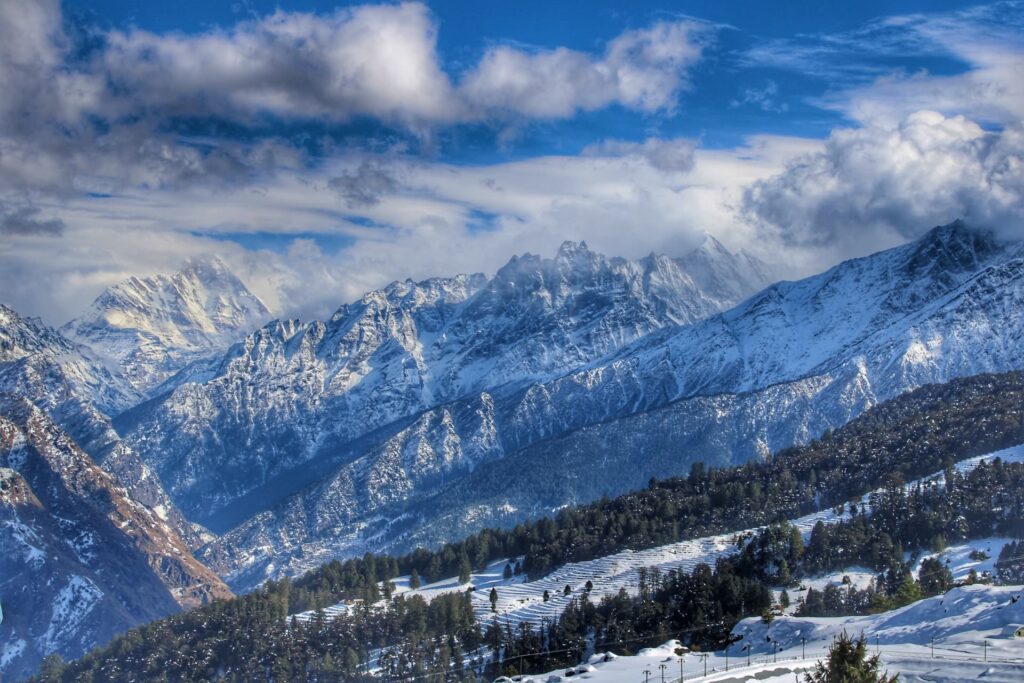
Natural Splendor Along the Trek
The Chopta Tungnath Trek and Chandrashila Trek are celebrated for their breathtaking natural splendor, drawing trekkers and nature enthusiasts alike to this Himalayan paradise. Every step on this trail reveals a new layer of beauty, from vibrant forests and alpine meadows to pristine mountain vistas and serene skies. Let’s delve into the various natural wonders that make this trek unforgettable.
Rhododendron Forests: A Vibrant Welcome
As you begin your trek from Chopta, the path winds through lush rhododendron forests. During spring, these trees burst into bloom, painting the landscape with vibrant hues of red and pink. The air carries the faint, sweet fragrance of the flowers, enhancing the magical experience. These forests are not only visually stunning but also provide a habitat for diverse bird species, making them a haven for birdwatchers.
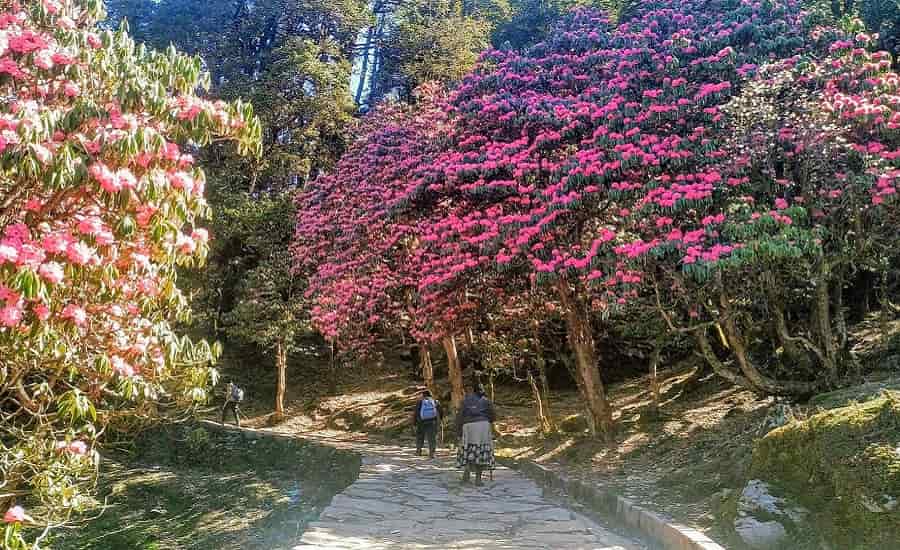
Alpine Meadows: A Green Oasis
The trek features expansive alpine meadows, locally known as “bugyals,” that roll like emerald carpets under the Himalayan skies. These meadows serve as grazing grounds for sheep and goats and are adorned with wildflowers during the summer months. The sight of the undulating green pastures against the backdrop of snow-capped peaks is nothing short of mesmerizing.
Towering Peaks: Nature’s Masterpieces
The trek offers uninterrupted views of some of the most iconic Himalayan peaks, including Nanda Devi, Trishul, Kedarnath, and Chaukhamba. These majestic mountains, with their snow-covered summits glistening in the sunlight, provide a stunning backdrop throughout the journey. The Chandrashila summit trek is particularly rewarding for its 360-degree panoramic views, making it a photographer’s dream.
Pristine Water Bodies: A Source of Serenity
The Chopta Chandrashila region is dotted with pristine water bodies that add to its charm. On your way, you may encounter small streams and rivulets, their crystal-clear waters reflecting the blue skies. Nearby, the serene Deoriatal Lake offers a tranquil detour. Surrounded by dense forests, this lake mirrors the towering peaks, creating a picture-perfect scene.
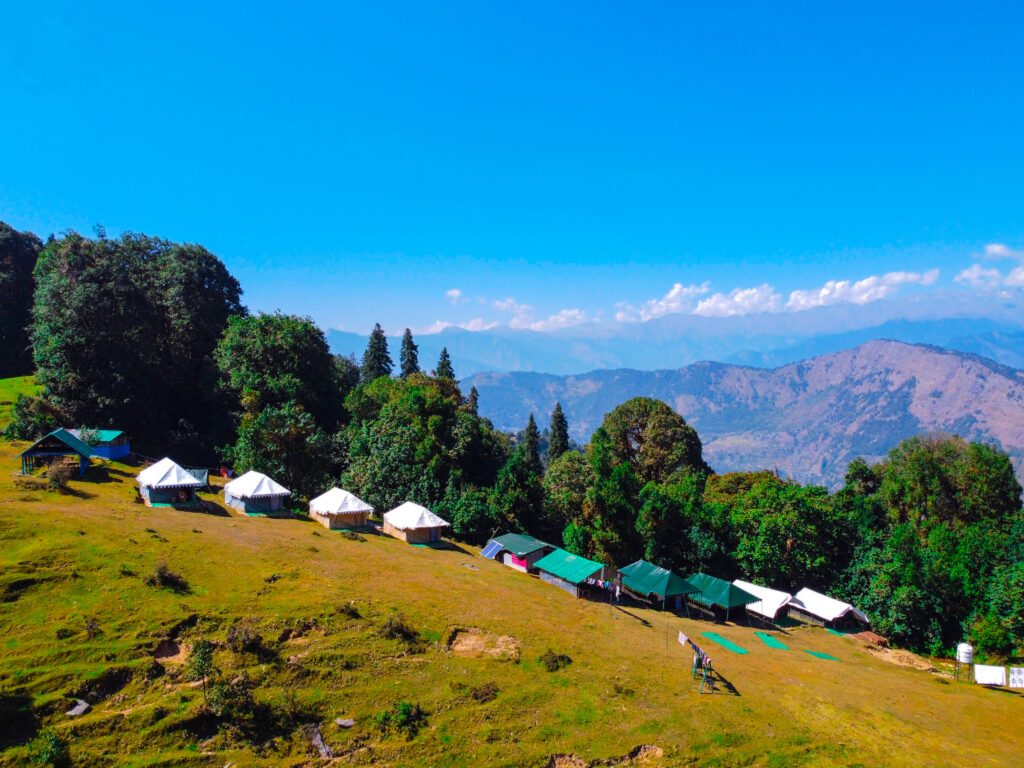
Wildlife Encounters: A Glimpse of Himalayan Biodiversity
The region’s rich biodiversity is another highlight of the trek. Trekkers often spot the Himalayan Monal, the state bird of Uttarakhand, with its iridescent plumage. Musk deer, barking deer, and a variety of butterflies can also be seen along the trail. The tranquil environment allows you to connect with nature while observing its inhabitants in their natural habitat.
Seasonal Splendor: Beauty in Every Season
- Spring: Witness blooming rhododendrons and vibrant wildflowers.
- Summer: Enjoy lush greenery and pleasant weather.
- Autumn: Experience clear skies and unobstructed mountain views.
- Winter: Marvel at snow-covered landscapes and frosted forests.
Stargazing: A Celestial Experience
Camping under the stars is a highlight of this trek. The lack of urban light pollution allows the night sky to come alive with countless stars, offering a celestial spectacle. On clear nights, you can spot constellations, shooting stars, and even the Milky Way, making it a magical experience.
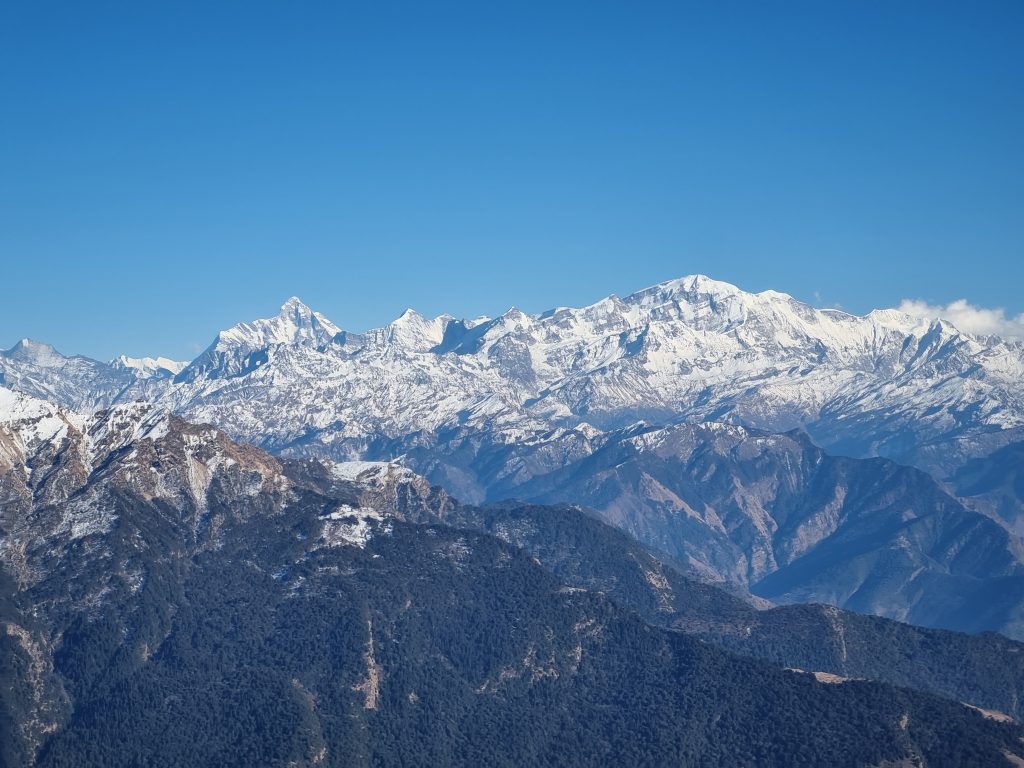
Eco-Friendly Trekking: Preserving the Splendor
As you explore the natural beauty along the Chopta Tungnath Trek and Chandrashila Trek, it’s essential to tread lightly. Practice eco-friendly trekking by avoiding littering, respecting wildlife, and sticking to designated trails. Sustainable tourism ensures that this pristine environment remains unspoiled for future generations.
Best Time to Visit Tungnath and Chandrashila
The ideal time to undertake the Chopta Chandrashila Trek depends on what you seek:
- Spring (March to May): Witness blooming rhododendrons and pleasant weather.
- Summer (June to August): Perfect for escaping the heat and enjoying lush greenery.
- Autumn (September to November): Clear skies and unobstructed views of the Himalayas.
- Winter (December to February): Experience a snow-covered landscape, turning the trek into a magical winter adventure.
Essential Trekking Tips for Tungnath Chandrashila Trek
- Gear Checklist:
- Comfortable trekking shoes
- Warm clothing
- Trekking poles
- First-aid kit
- Physical Preparation:
- Engage in cardio exercises and strength training at least a month before the trek.
- Acclimatize properly to avoid altitude sickness.
- Travel Light: Carry only essentials to avoid unnecessary strain.
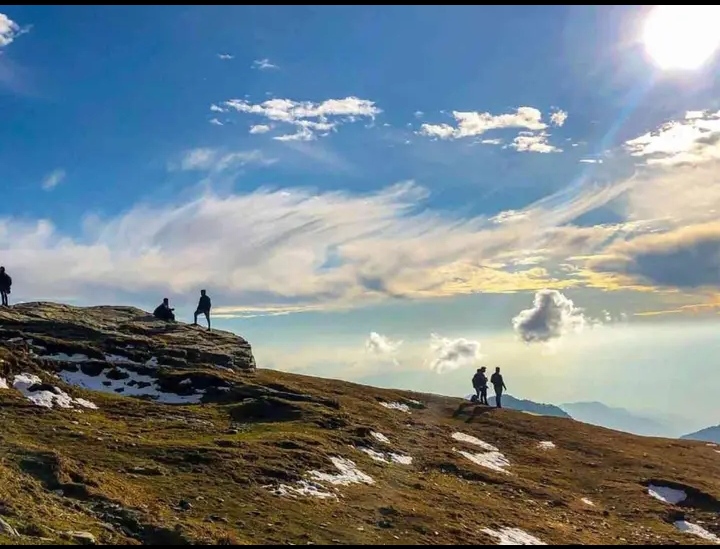
Camping and Accommodation Options in Chopta
Chopta, often referred to as the “Gateway to Tungnath,” is a serene destination offering various camping and accommodation options for travelers embarking on the Chopta Tungnath Trek or the Chandrashila Trek. Whether you seek rustic camping under the stars or comfortable lodges with modern amenities, Chopta caters to every type of traveler. Here’s a look at the best options available:
Camping in Chopta: Embrace Nature
Camping is a quintessential experience in Chopta, allowing you to immerse yourself in the pristine environment. Many trekking enthusiasts prefer camping near Tungnath or along the trail to Chandrashila. Popular campsites include:
- Alpine Camps: These camps offer basic amenities with spacious tents, cozy sleeping bags, and bonfire arrangements. They’re ideal for trekkers on the Chopta Tungnath Trek and Chandrashila Trek.
- Luxury Camps: For those seeking comfort, luxury camps provide plush tents equipped with attached bathrooms, dining facilities, and panoramic views of the Himalayan peaks.
- Eco-Friendly Camps: These camps focus on sustainability, offering eco-friendly setups that blend seamlessly with nature. They’re perfect for travelers who prioritize green tourism.
Camping in Chopta often includes meals, guided treks, and opportunities for stargazing, making it a complete package for adventure lovers.
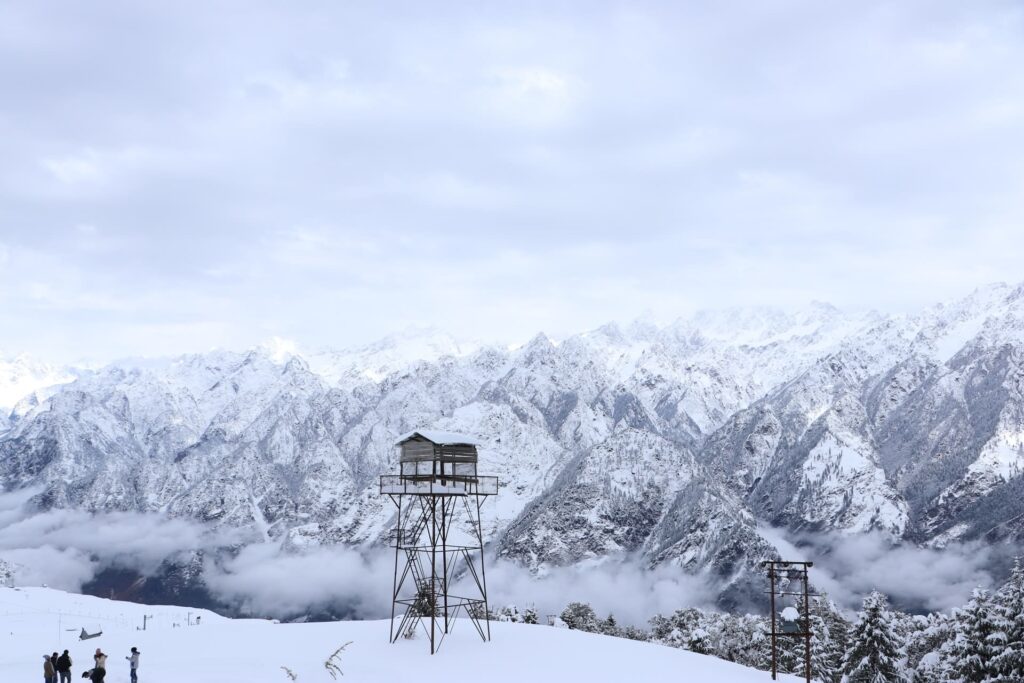
Lodges and Guesthouses: Budget-Friendly Options
For trekkers who prefer a roof over their heads, Chopta offers a range of lodges and guesthouses. These accommodations provide:
- Affordable Rates: Many lodges offer budget-friendly rooms, making them a great choice for travelers on a budget.
- Proximity to Trails: Located near the starting points of the Tungnath Temple Trek and Chandrashila Summit Trek, these lodges are convenient for trekkers.
- Homely Comfort: Guesthouses often provide home-cooked meals and a warm atmosphere, giving travelers a taste of local hospitality.
Resorts: Luxury Amidst Nature
If you’re looking for a more luxurious stay, several resorts in and around Chopta offer premium amenities. These include:
- Scenic Views: Resorts provide unobstructed views of the Himalayas, allowing guests to wake up to breathtaking landscapes.
- Modern Facilities: Amenities such as Wi-Fi, hot water, and multi-cuisine restaurants ensure a comfortable stay.
- Activities: Many resorts organize guided tours to Tungnath Chandrashila Trek from Delhi or Chopta Chandrashila Trek packages, enhancing the overall experience.
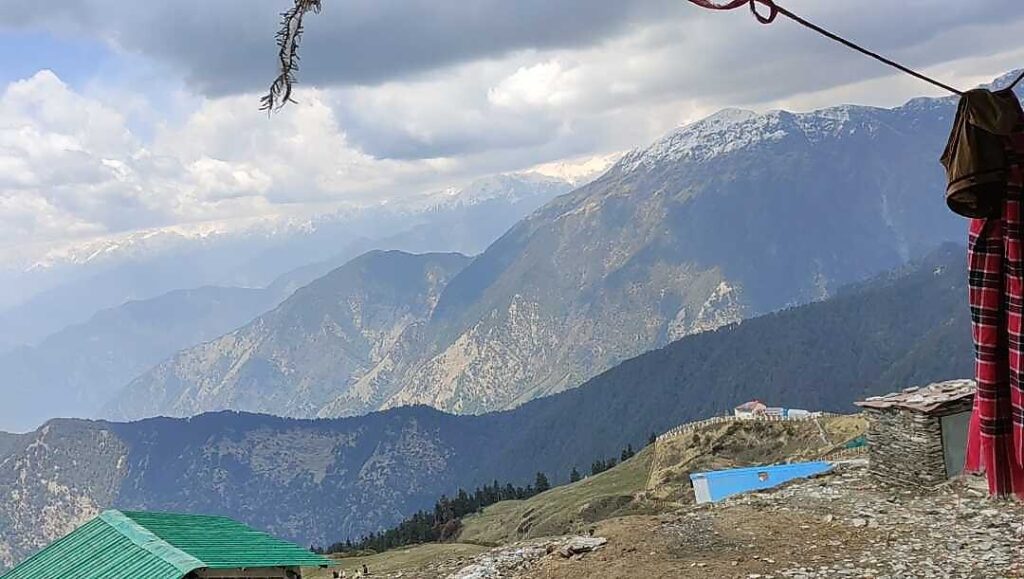
Homestays: A Cultural Connection
For those wanting to connect with the local culture, homestays in Chopta are an excellent choice. Staying with a local family gives you insight into their traditions, cuisine, and way of life. Homestays also provide basic facilities and a unique personal touch that larger accommodations can’t match.
Adventure Beyond Trekking: Activities to Enjoy in Chopta
While trekking is the main attraction, Chopta offers other exciting activities:
- Bird Watching: Spot rare Himalayan bird species.
- Photography: Capture the breathtaking landscapes and vibrant flora and fauna.
- Exploring Nearby Trails: Discover hidden gems like Deoriatal Lake and Kanchula Korak Musk Deer Sanctuary.
Local Culture and Cuisine: Savoring the Spirit of the Himalayas
Chopta, the picturesque gateway to the Chopta Tungnath Trek and Chandrashila Trek, is not just about breathtaking landscapes and thrilling treks. The region is also steeped in rich local culture and delectable cuisine, offering visitors a chance to connect with the vibrant spirit of the Himalayas. From traditional festivities to mouth-watering local dishes, Chopta provides an immersive experience for those keen to explore beyond its natural beauty.
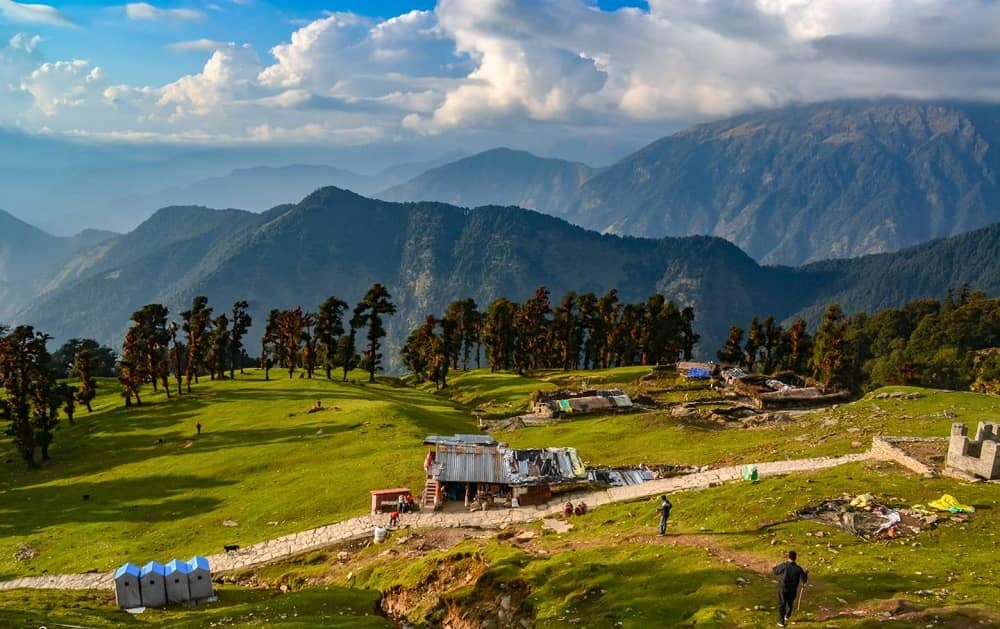
The Essence of Local Culture in Chopta
Chopta is part of the Garhwal region of Uttarakhand, a place where age-old traditions and customs thrive. The locals, primarily belonging to the Garhwali community, live in harmony with nature, preserving their unique heritage.
- Festivals and Celebrations: Festivals in Chopta and surrounding villages reflect the spiritual essence of the region. The annual celebrations of Basant Panchami and Nanda Devi Raj Jat are vibrant occasions marked by traditional music, dance, and rituals. These events often coincide with trekking seasons, adding a cultural dimension to the Chopta Tungnath Trek or Chopta Chandrashila Trek.
- Art and Craft: The local craftsmanship is evident in items like handwoven woolens, wooden carvings, and decorative artifacts. Travelers can often find souvenirs in nearby villages, adding a touch of Himalayan artistry to their collections.
- Folklore and Traditions: Locals love to share ancient tales about Tungnath and Chandrashila, enriching the trekking experience with fascinating stories. These legends, passed down through generations, are a window into the spiritual significance of the Tungnath Temple Trek and the Chandrashila Summit Trek.
Cuisine: A Taste of the Himalayas
The culinary traditions of Chopta are simple yet deeply satisfying. Local cuisine is heavily influenced by the region’s climate and agriculture, featuring fresh, organic ingredients.
- Staple Foods: The diet in Chopta revolves around lentils, rice, and vegetables. Signature dishes like Mandua Roti (millet bread) and Phaanu (a lentil-based dish) are wholesome and rich in nutrients, perfect for fueling up before a trek.
- Unique Flavors: Don’t miss trying Aloo Ke Gutke, a spicy potato dish, and Kafuli, a green curry made from leafy vegetables. These dishes are often served with a side of fresh chutneys made from locally grown herbs.
- Sweets and Beverages: For dessert, savor Jhangora Kheer, a sweet pudding made from millet, or Singori, a traditional sweet wrapped in a leaf. Warm yourself with Buransh Juice, made from the petals of the rhododendron flower, a local specialty.
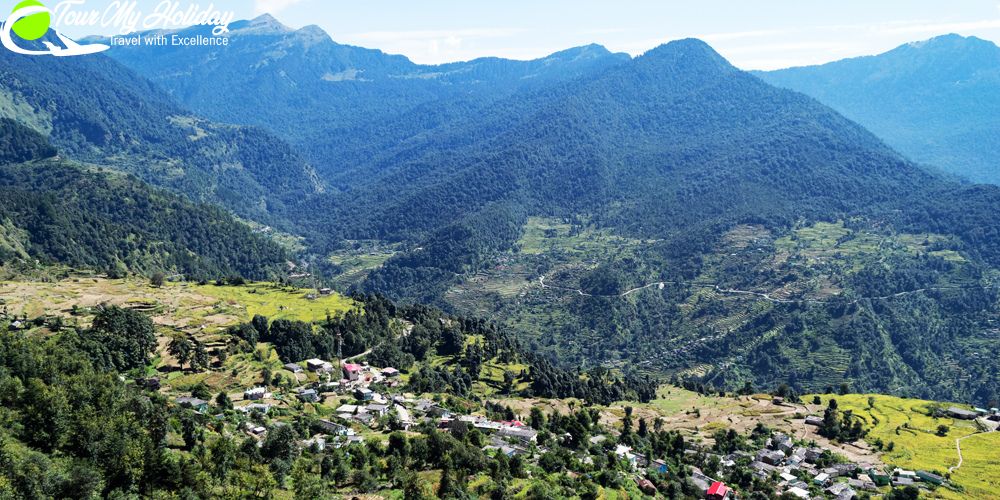
Homestays: A Gateway to Cultural Exchange
Staying in a homestay is one of the best ways to experience the local culture. Homestays allow visitors to:
- Interact with Locals: Share meals and conversations with host families who are often happy to narrate stories about the Tungnath Temple Trek and Chopta Chandrashila Trek.
- Learn Traditional Recipes: Guests can participate in cooking sessions to learn how to prepare dishes like Mandua Roti and Kafuli.
- Experience Local Hospitality: Warm and welcoming, homestay hosts ensure that guests feel at home while experiencing authentic Garhwali life.
Cultural Highlights Along Trekking Routes
The trails leading to Tungnath and Chandrashila are dotted with villages and sacred sites that offer glimpses into local traditions:
- Sari Village: Often the starting point for the Chandrashila Trek, this village is known for its serene vibe and traditional Garhwali architecture.
- Tungnath Temple: As the highest Shiva temple in the world, Tungnath is a significant spiritual site where locals conduct regular rituals and prayers.
- Chandrashila Summit: Beyond its panoramic views, the summit is steeped in mythological tales that add depth to the trekking experience.
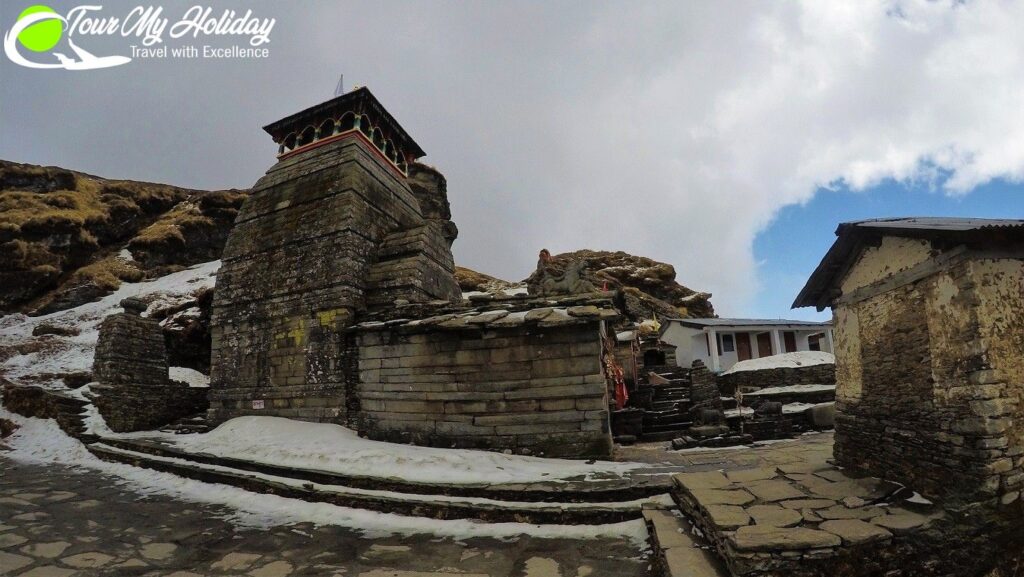
Cultural Etiquette for Visitors
While exploring Chopta and engaging with locals, it’s essential to respect their customs and way of life:
- Dress Modestly: Especially when visiting temples or attending festivals.
- Follow Local Rituals: Participate in cultural practices if invited, but always ask for guidance.
- Support Local Economy: Purchase handicrafts and eat at local establishments to contribute to the community.
Sustainable Trekking: Preserving the Pristine Ecosystem
The Himalayan region, including Chopta, is a natural treasure trove that demands conscientious efforts to preserve its delicate ecosystem. With trekking routes like the Chopta Tungnath Trek and Chandrashila Trek gaining popularity, it becomes imperative for trekkers and tour operators to adopt sustainable practices. By doing so, we ensure that future generations can also experience the untouched beauty of this region.
Understanding the Impact of Trekking on Ecosystems
Trekking is a thrilling activity, but it often comes with environmental consequences. Trails such as the Tungnath Temple Trek and the Chandrashila Summit Trek traverse through rich biodiversity zones, including meadows, dense forests, and fragile alpine regions. Increased footfall in these areas can lead to:
- Soil Erosion: The constant movement of trekkers can erode trails, leading to landslides and habitat destruction.
- Waste Accumulation: Plastic bottles, food wrappers, and other non-biodegradable waste left behind by trekkers are detrimental to the environment.
- Disturbance to Wildlife: Noise and intrusion can disrupt the natural behaviors of Himalayan fauna, such as musk deer, monals, and snow leopards.
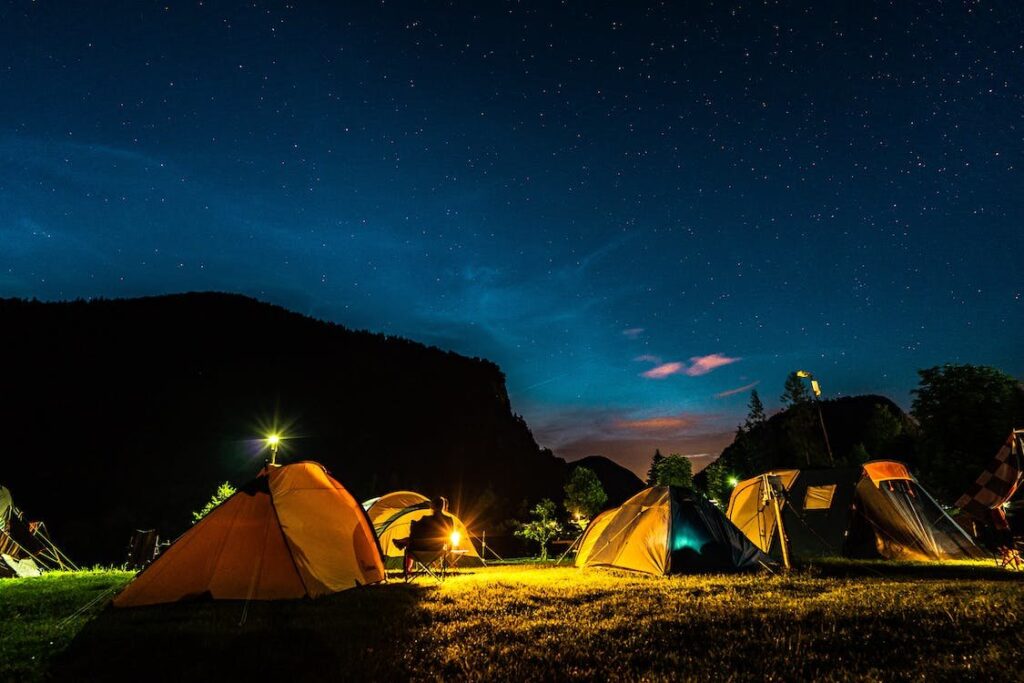
Principles of Sustainable Trekking
To preserve the pristine beauty of trekking routes like the Chopta Chandrashila Trek, adopting sustainable practices is crucial. Here are key principles to follow:
- Leave No Trace: Carry all waste, including biodegradable items, back with you to designated disposal areas.
- Stick to Marked Trails: Avoid creating new paths, as this can damage vegetation and disturb wildlife habitats.
- Limit Group Sizes: Smaller trekking groups reduce the impact on trails and resources.
- Respect Local Communities: Engage with locals respectfully, support their economies by using homestays, and follow cultural norms.
Eco-Friendly Practices for Trekkers
To minimize your ecological footprint while embarking on treks such as the Chopta Chandrashila Trek from Delhi, consider adopting these eco-friendly habits:
- Carry Reusable Gear: Bring reusable water bottles, utensils, and bags to avoid single-use plastics.
- Opt for Sustainable Tour Packages: Choose Chopta tour packages that prioritize eco-tourism and include measures for environmental conservation.
- Use Eco-Friendly Toiletries: Biodegradable soaps and shampoos prevent contamination of water sources.
- Travel Responsibly: Opt for public transportation or shared rides to reduce carbon emissions.
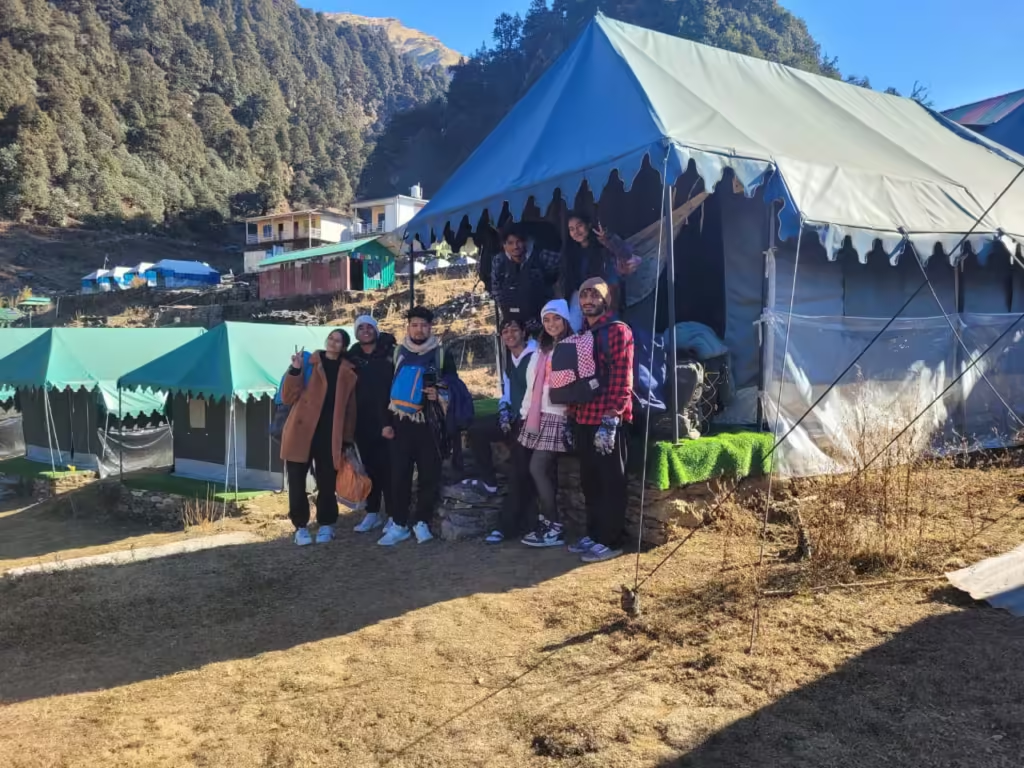
Sustainable Camping in Chopta
Chopta is a popular camping destination. To ensure your camping trip aligns with sustainable trekking practices:
- Set Up Camps in Designated Areas: Avoid pitching tents in fragile ecosystems or near water bodies.
- Minimize Campfire Impact: Use portable stoves instead of open fires, which can harm soil and vegetation.
- Clean Up Thoroughly: Leave the campsite cleaner than you found it.
Community Involvement in Sustainable Trekking
The local communities of Chopta play a vital role in preserving the region’s natural beauty. By integrating their knowledge and practices into your trekking journey, you contribute to a sustainable future:
- Support Local Guides: Hiring local guides for the Tungnath Chandrashila Trek from Delhi ensures accurate navigation while supporting local livelihoods.
- Promote Eco-Tourism Initiatives: Participate in programs that educate trekkers about environmental conservation.
- Encourage Conservation Efforts: Advocate for policies that prioritize the preservation of Chopta’s natural resources.
Role of Tour Operators in Sustainability
Tour operators offering Chopta Tungnath Trek from Delhi or Chopta tour packages have a responsibility to prioritize sustainability. They can:
- Educate Trekkers: Provide information on eco-friendly practices before the trek begins.
- Organize Clean-Up Drives: Conduct regular initiatives to clear trekking routes of waste.
- Promote Off-Season Treks: Reducing overcrowding by promoting treks during less popular months.
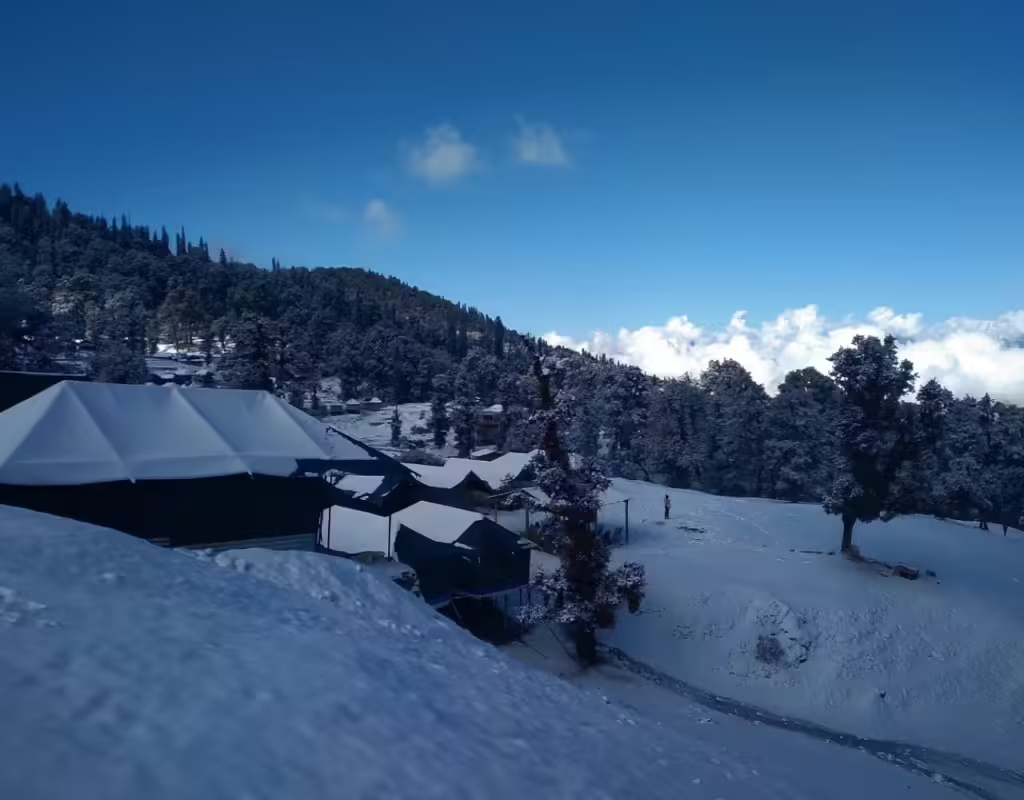
Conservation Success Stories in Chopta
Efforts to protect Chopta’s ecosystem have yielded positive outcomes:
- Reforestation Projects: Local NGOs have undertaken tree plantation drives to restore degraded forest areas.
- Wildlife Protection Measures: Conservation programs have increased sightings of the endangered monal pheasant, Uttarakhand’s state bird.
- Community-Led Tourism: Homestays and local businesses are adopting eco-friendly practices, benefiting both the environment and visitors.
Sustainable Trekking Gear
Investing in sustainable gear can significantly reduce your environmental impact. For treks like the Tungnath Temple Trek or Chandrashila Summit Trek, consider:
- Solar-Powered Devices: Use solar chargers for electronics to avoid disposable batteries.
- Eco-Friendly Apparel: Wear clothing made from recycled or natural materials.
- Lightweight Equipment: Reduce the strain on trails by carrying lighter, compact gear.
Balancing Adventure and Responsibility
The thrill of trekking the Chopta Tungnath Trek lies in its untouched beauty. However, preserving this allure requires conscious efforts from every trekker. By embracing sustainable practices, you ensure that Chopta remains a sanctuary for both its natural inhabitants and future visitors.
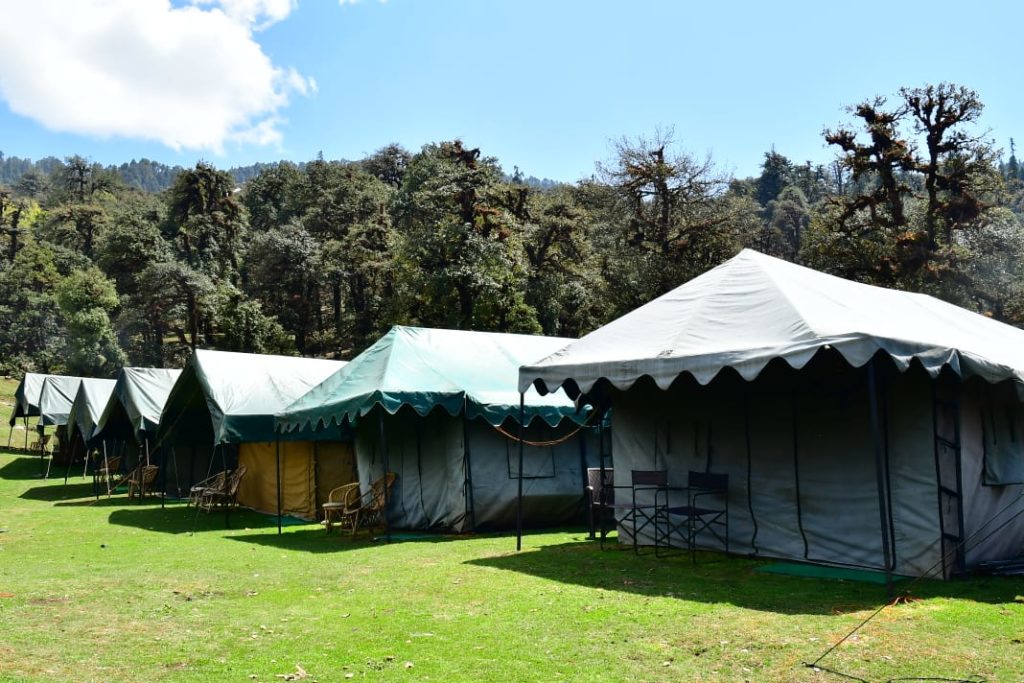
FAQs About the Tungnath Temple Trek
General Information
- What is the Tungnath Temple Trek?
The Tungnath Temple Trek is a scenic Himalayan trek leading to the highest Shiva temple in the world, located in the Garhwal region of Uttarakhand. - Where is Tungnath Temple located?
Tungnath Temple is situated at an altitude of 3,680 meters in the Chopta region of Uttarakhand, India. - Why is Tungnath Temple significant?
It is the third temple in the Panch Kedar circuit and is revered for its spiritual and historical importance in Hinduism. - How long is the Tungnath Temple Trek?
The trek is approximately 3.5 kilometers one way from Chopta to Tungnath Temple. - What makes the Tungnath Temple Trek unique?
The trek combines natural beauty, spiritual significance, and panoramic views of snow-capped peaks like Nanda Devi, Trishul, and Chaukhamba.
Trek Details
- Is the Tungnath Temple Trek difficult?
It is a moderate trek suitable for beginners with basic fitness levels. - How long does it take to complete the trek?
The trek can be completed in 3-4 hours one way, depending on your pace. - What is the Chandrashila Summit, and is it part of the trek?
The Chandrashila Summit is located 1.5 kilometers beyond Tungnath Temple and offers a stunning 360-degree view of the Himalayas. - Are guides required for the Tungnath Temple Trek?
While the trail is well-marked, hiring a guide can enhance your experience by providing local insights. - Can children or elderly people do the Tungnath Temple Trek?
Yes, with proper preparation and breaks, it is manageable for children and elderly individuals in good health.
Best Time to Visit
- What is the best time to trek to Tungnath Temple?
The best time is from April to November, avoiding the monsoon months (July and August) due to slippery trails. - Is it possible to trek Tungnath during winter?
Yes, but the trail can be challenging due to snow. The temple remains closed in winter, and you may need additional gear. - Can I see snow on the Tungnath Temple Trek?
Yes, snow is common during winter and early spring (December to March). - What weather should I expect during the trek?
Expect cool temperatures, with warmer days and chilly nights. Always check weather conditions before trekking. - Are there any festivals or events celebrated at Tungnath?
Maha Shivratri and other Hindu festivals are celebrated with great enthusiasm when the temple is open.
Logistics
- How do I reach the starting point of the trek?
The trek starts from Chopta, which can be reached by road from cities like Rishikesh, Haridwar, or Dehradun. - Are there accommodation options near Tungnath?
Yes, Chopta offers basic guesthouses, campsites, and homestays for trekkers. - What should I pack for the Tungnath Temple Trek?
Essentials include trekking shoes, warm clothing, a raincoat, water bottles, snacks, and first-aid supplies. - Are there food and water facilities along the trail?
Small tea stalls and eateries are available on the trail, but carrying your water and snacks is recommended. - Can I combine the Tungnath Trek with other treks?
Yes, the Tungnath Temple Trek is often combined with the Chandrashila Trek for an extended experience.
Safety and Preparation
- Is the trek safe for solo travelers?
Yes, the trail is safe and popular, but always inform someone about your plans and carry basic safety equipment. - What are the health requirements for the trek?
A basic level of fitness is sufficient, but those with pre-existing conditions should consult a doctor. - Are permits required for the Tungnath Temple Trek?
No special permits are required, but always follow local guidelines. - What should I do in case of an emergency on the trail?
Carry a first-aid kit, and in case of severe issues, contact local guides or rescue teams available in Chopta. - How can I make the trek eco-friendly?
Avoid littering, use reusable water bottles, and respect local customs and wildlife to preserve the natural beauty of the region.

